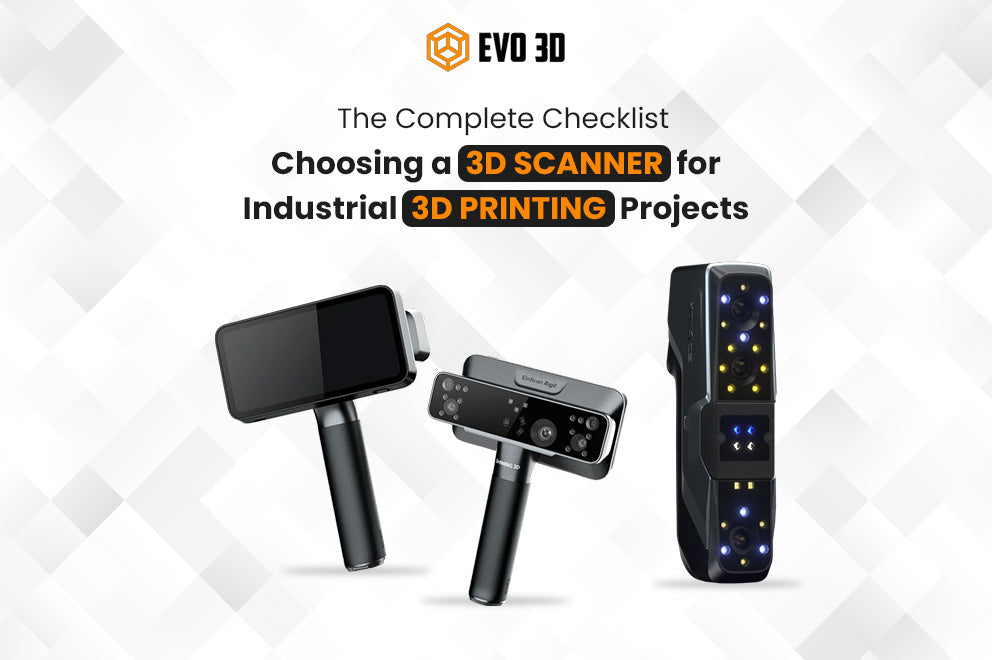The Complete Checklist: Choosing a 3D Scanner for Industrial 3D Printing Projects

Precision is paramount in industrial 3D printing, and that precision begins far in advance of a part ever coming near a 3D printer. It starts with a digital version, which is often recorded by an industrial 3D scanner. Whether scanning existing parts or creating from scratch, 3D scanning provides the dimensional accuracy and surface detail necessary to offer confident, repeatable print outcomes.
These scanners are the bridge between physical models and digital fabrication. In this guide, you'll receive a hands-on checklist to help you through choosing the best 3D scanner for your use, whether you're adding on to your established system or embarking on industrial scanning for the first time. Let's ensure your next scan not only appears great, but it runs perfectly with your 3D printer.
How to Choose the Right Industrial 3D Scanner for Your 3D Printing Workflow?
Selecting the optimal 3D scanner is about selecting the one that is best suited to your workflow, materials, and production needs. Here's a checklist on how to assess what really counts when investing in an industrial 3D scanner for your 3D printing facility.
1. Scanning Accuracy & Resolution
Detailed parts require high-resolution scans, particularly when dealing with close tolerances.
Tip: Find scanners with micron-level accuracy if you're making functional or precision parts.
Why it matters: Inaccuracy can cause printing defects, dimensional drift, or post-processing aggravation.
2. Scanning Speed
Speed makes and breaks your workflow in high-volume environments.
Tip: Assess the scan time per object and batch-scanning capabilities.
Why it matters: Quicker scans translate to faster iterations and less production downtime.
3. Compatible Object Sizes
From small dental parts to big auto components, size is an issue.
Tip: Make sure the scanner will accommodate your most frequent part sizes—or opt for a modular system for versatility.
Why it matters: Scanners that cannot accommodate your parts will be a production drag or require expensive workarounds.
4. Surface Material & Finish Handling
Not all scanners treat reflective, dark, or translucent surfaces the same.
Tip: Search for an industrial 3D scanner with multiple light sources or surface-specific filters.
Why it matters: Incompatible surfaces result in noise in the scan data or crashed captures.
5. 3D Printing Software Integration
Smooth compatibility eliminates headaches and maximizes workflow efficiency.
Tip: Opt for a 3D scanner that outputs in compatible formats for your 3D printer and slicing software.
Why it matters: Poor file compatibility equals lost time repairing meshes or rebuilding models.
Common Mistakes to Avoid When Buying an Industrial 3D Scanner
One of the greatest errors is selecting based on price rather than performance. It's tempting to opt for a lower-priced alternative, yet industrial applications require reliability, speed, and accuracy. Forgetting about software compatibility is another usual mistake. You may spot a scanner with great specifications, but if its output is not easily compatible with your CAD software or 3D printer application, you are in for a rough experience.
And then there's post-processing, a step that gets short-changed. Industrial scans, particularly higher ones, need cleaning, aligning, and mesh optimization before they're suitable for print. Finally, never underestimate vendor training and support. Purchasing a scanner is only the beginning. Without professional onboarding, help desk support, and periodic updates, even superior hardware will fail.
Why Choose Evo3D for Industrial 3D Scanners?
Picking an industrial 3D scanner is the starting point for creating a seamless, efficient, and scalable 3D printing process. With the proper scanner, you minimize waste, accelerate production, and open the doors to new applications. Here at Evo3D, we provide a handpicked selection of industrial 3D scanners designed to satisfy the varying needs of manufacturers, engineers, and design experts.
Whether you're scanning big parts or small, high-detail components, our inventory is engineered to thrive in the real world and in production environments. We tailor your experience to your workflow, software ecosystem, and the goal of the application. From first consultation through post-purchase training and integration, our staff is committed to your 3D scanner becoming valuable alongside your 3D printing system.
With Evo3D, let's create a smarter workflow, beginning with your next scan.
